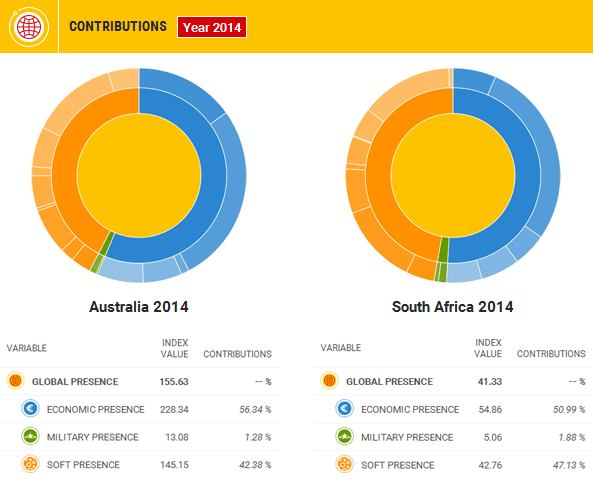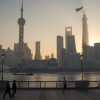Original version in Spanish: Política exterior y presencia global: las estrategias de Australia y Sudáfrica
Theme
This ARI examines the insertion in the globalisation process of Australia and South Africa in terms of global presence in order to determine whether they match the model outlined in their strategic foreign policy documents.
Summary
Are national foreign-policy strategies effectively defining the national interest in countries far from their own borders? Do the objectives sketched out in national strategic documents evolve in accordance with these foreign-policy profiles? To answer these and other questions, we shall analyse the external projection (as it relates to documents of strategic reference) of two countries confrontingglobalization in different ways: Australia, a middle power, and the Republic of South Africa, an emerging country. The analysis of the Australian case exposes an external insertion based on the economic dimension, with primary and energy goods prominent, which follows the path marked by its strategic documents. South Africa, meanwhile, considers the exercise of regional leadership as the foundation of its influence in the international order but, in terms of global presence, it might seem that Nigeria would have taken the leading position due to the growth experienced in recent years.
Analysis
Across the four corners of the world, many are the nations that have had to reflect on their current role in the complex international scenario defined by globalisation, identifying both risks and opportunities while addressing their own national interests. Some countries have risen to this challenge by collecting into strategic documents or white papers a series of actions and goals to be achieved, in order to optimise their position on the global stage. Such exercises in planning can help not only to better understand the continuous transformations at play in the international arena, but can also contribute to a more transparent, inclusive and predictable foreign-policy.1
The Elcano Global Presence Index is not merely a useful tool for decoding the globalisation process, its evolution and its tendencies; the index is also an effective, significant foreign-policy instrument. By determining the global presence of the 80 countries examined in the index –using the three broad dimensions and the multiple variables on which they are based– we can verify how a country (or group of countries) is managing to conform its external projection, whether via soft dimension variables (science, development cooperation, tourism) or via hard dimensions (economic or military, including energy, investments, military equipment, etc). The profiles for global presence are like X-ray photos, allowing us to capture the nature of a nation’s external projection, its strengths and weaknesses, detailing the different ways that countries regard globalisation and their potential role in it, their methods of maximising the opportunities it represents in order to gain international influence or to fulfil their own national agendas.
Towards a prosperous Australia: the ‘competitive liberalisation’ of the markets
The philosophical and practical principles guiding the strategy for Australian Foreign Policy and Trade were collected for the first time in 1997, in a document titled ‘In the National Interest’.2 The document was revised once in 2003 and re-published under the title ‘Advancing the National Interest: Australia’s Foreign and Trade Policy White Paper’, and though a great number of strategic documents have been published since then they deal mostly in sectoral terms and provide a much less panoramic view.
In the White Paper the country defines itself as a medium-sized power operating within globalisation, a phenomenon that Australia regards in unquestioningly optimistic terms as an opportunity in ‘times of uncertainty’ which can yield substantial profits to all countries. The document goes on to define Australia as a ‘liberal democracy proud of its commitment to the values of political and economic liberty’ –values that have strengthened the nation’s international position–. As a country with a multicultural society, whose origin and history have been based on immigration, Australia is accustomed to looking beyond its own borders. At the same time, being located in the Asia-Pacific region, Australia is an insular and Western state with strong social, economic and cultural links to the US and Europe. The country’s national interest is summarised as ‘the security and prosperity of Australia and Australians’.
The strategic goals of Australia’s international insertion are essentially conducted through economic integration. Hence the document proposes an ambitious commercial agenda of ‘competitive liberalisation’ of the markets, using ‘bilateral and multilateral channels’ to face the competitiveness embodied by expanding markets and emerging economies, and dealing not only in terms of agricultural products and textiles but also the increasing availability of manufactured goods. Consequently, Australia has planned for genuine economic integration via exports of primary goods (agricultural, mining, wine), manufactures and services (for example, related to its nascent automobile sector), and energy, along with financial investments.3
Within the soft dimension, the vast potential of the country’s multicultural society is emphasized for encouraging “the interpersonal relationships contributing to our international status”4, another principal strategic goal. In this sense, in addition to Australian citizens living within the country, one considers also those born or living abroad, as well as the considerable number of foreign students living in Australia plus, of course, tourism. The intention here is to project an image of a successful and sophisticated country grounded on scientific and technological knowledge and sports achievements. Australian development aid is also part of the soft agenda given the ‘moral duty to eradicate poverty’, although such aid primarily focuses on good governance in the region.
Concerning security, Australia presents in its Strategic Plan a solid commitment to the war against terrorism encouraged by the US following the 9/11 attacks in New York and Washington DC.5
Has the nature of Australian external projection progressed according to these strategic positions?
In 2005, two years after the approval of its White Paper, Australia was ranked 12th among the 80 countries now included in the Elcano Global Presence Index. Its profile was at that time built upon the soft dimension (representing 55.4% of its total global presence), followed by its economic (43.9%) and military presences (2%). Five years later, in 2010, Australia maintained the same position, although the economic variable increased its weight by 3.7 percentage points at the expense of the soft variables and the military, which fell by 3.2 and 0.5 points, respectively. In the latest index (2014), the country dropped one position to 13th, reinforcing an observed tendency towards an economy-based external projection profile (Graph 1). For the first time, Australia’s economic dimension exceeded its soft dimension, rising to account for more than half of all the nation’s global presence (at 56.3%, to be precise). The contributions related to the military presence continued to decrease, indicating that Australian involvement in the war against global terrorism is not reflected in terms of its global presence.

This turn towards the economic is also evident when analysing the index value (Graph 2). Departing from similar values in 2005 (economic and soft presence indexed at 93.8 and 97.0 points, respectively), the progress in the economic area is remarkable throughout the next 10 years, and by 2014 it had risen to over 228, gaining 134.4 points while the soft variable gained only 48.2). The largest expansion of economic variables occurred during the five-year period from 2010 to 2014, when it outpaced the soft variables set by 68.5 points.
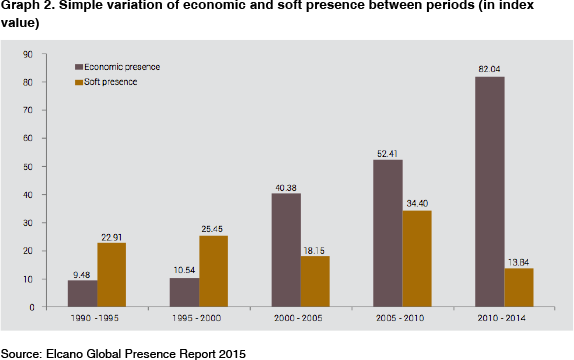
Finally, in terms of Australia’s presence within the global scenario, which is to say in direct competition with the other 79 countries included in this index, the share of its economic presence increased from 1.8% to 2.2% between 2005 and 2010. This in a context of general expansion of globalisation, chiefly economic, where emerging economies managed to seize positions previously occupied by the traditional, post-industrial powers (the model here being the case of China).
Regarding the variables that most define the Australian profile beyond its borders, in 2005 they were basically four: education (with a 17.5% contribution), primary goods (17.3%), sports (15.3%) and energy (11.9%). All of these factors became increasingly important between 2005 and 2014, although their individual evolutions were distinct. In 2010, the soft dimension variables experienced a slight increase (education to 17.7%) or decrease (sports to 12.6%), while both economic dimensions rose: primary goods to 18.8% and energy to 13.85%. The trend continued into 2014, when primary goods became consolidated as the leading variable with a relative weight of 27% (Graph 3). Immediately behind this were energy resource exports (at 15%) and, with a drop of 4.5 percentage points since 2005, education (at 13%). Among the variables included in the ‘other’ category, the most outstanding were portions of the service sector, practically constant through the 10-year period, and aid cooperation, increasing by a total of 1.6 points.
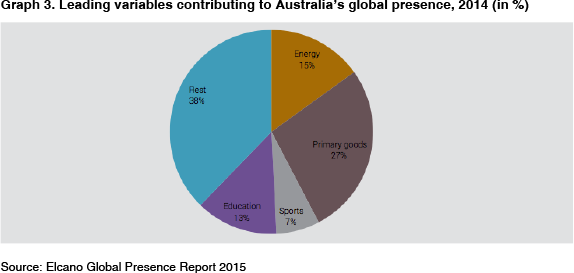
In summary, in-depth variable analysis shows an external insertion based on primary goods exports (essentially agricultural products, a strategic sector for this continent/country) and energy resources (also key to Australia’s relationships within the Asia-Pacific region, its primary area of influence). Attracting more international students to Australia, as a way of establishing bonds with foreign countries, also counts among the country’s greatest strengths. In this regard, although Australia’s weight in global presence terms of education has lately declined, one must bear in mind its exceptional ‘starting point’ in 2005, along with the outstanding rise of other economic variables supporting the national strategic goals identified by the White Paper.
Thus our analysis of the index variables on Australian global presence and their evolution since 2005 leads us to conclude that the country has indeed continued on the path laid out by its own strategic foreign-policy document of 2003, combining the dual aspirations of strong international projection and a more prosperous and secure nation.
The South African case: can regional leadership lead to a stronger global influence?
The year 2005 was a turning point for the Republic of South Africa, marking ‘the beginning of a second decade under democracy, coinciding with the 50th Anniversary of the proclamation of the Freedom Charter by the People’s Congress’, as stated in the country’s strategic foreign-policy plan for 2005-086 addressing the national vision and goals for the medium term. Revealing a strong inclination to place South Africa in a regional leadership position, with a commitment to the African continent, the country’s foreign-policy strategy was assembled around the ‘building of a new Africa in which peace and security will endure, moving deeper into democracy and prosperity so the quality of life for African people will keep continuously improving’.7
When in 2009 the Ministry of Foreign Affairs changed its name to the Department of International Relations and Cooperation (DIRC), this was a strategic move, largely intended to connect the country’s national project with what was currently happening in the region around South Africa. A period of reconsideration began, culminating with the composition of a reference document regarding external action: a White Paper under the title of ‘Building a Better World: The Diplomacy of Ubuntu’,8 approved by the cabinet and now under parliamentary consideration.
The document reaffirms the basic principles guiding the South African spirit that was expressed in 2005, focusing on respect for other nations, people and cultures (‘the Diplomacy of Ubuntu’) and on South-South cooperation, in contrast to colonialism. South Africa’s ultimate goal was none other than to prepare the country ‘to become a winning nation in the coming decades of the 21st century’.9 Consequently, the national interest was closely related to the ‘stability, unity and prosperity of Africa’, specifying that ‘South Africa’s future global and continental standing will be determined by how South Africa remains true to its enduring values, economic success, and the continued leadership role on the continent’.10 Clearly, such regional leadership is defined as a major strategic goal from which to achieve stronger influence within the global order.
South Africa’s self-image in 2005 was that of an influential country within the African continental context, but with an international scope, supported broadly by its principles and values and a competitive, sustainable global economy.11 Therefore, the country’s economic diplomacy should lead the government and other agents for external action to try and bring down trade barriers for South African products, to identify and open new markets and to attract investments and tourism. All this, of course, further implies improvements in the competitiveness of national goods and services, while at the same time South Africa’s reputation as a responsible and stable supplier was to remain as before. In order to accomplish these targets, some strategic movements have been established which could be roughly summarised as integration (and diversification) in global markets, supporting the country’s exports of natural resources, the creation of a more productive business setting, innovation for new market opportunities and the implementation of measures to attract tourism.12
South African regional leadership in terms of global presence?
South Africa considers its own regional leadership as a solid base for becoming a global influence. However, in considering global presence rankings, the better-positioned country within the Sub-Saharan African region (including Angola and Sudan) is not South Africa but Nigeria, which has climbed 13 positions to number 36 (since the first index, estimated for 1990). For its part, South Africa is now ranked two positions below Nigeria, in 38th place (Table 1), while its improvement within the index has been well below Nigeria’s, having risen only four positions since 1990. Angola and Sudan appear much further down the list, in the second half of the table, positioned at numbers 54 and 77, respectively.
Considering the presence by dimensions of these two regional leaders in the context of the index, South Africa tops the soft presence ranking, but is surpassed by Nigeria in both the economic and military dimensions. Still, regardless of whether Nigeria has changed its position in the economic rank, South Africa has fallen 14 positions in this area since 1990. Meanwhile, the opposite has occurred in terms of the soft dimension: South Africa has climbed 11 positions, while Nigeria has dropped 10 in the ranking. As for military presence, both African countries have shown an improvement in their positions since the early 1990s.

On the basis of these global presence rankings, Nigeria and not South Africa is currently in the regional leadership position. However, through in-depth analysis of the nature of the countries’ external projection –of the global presence variables and dimensions and how they interrelate– a slightly different interpretation can be made.
The external projection of the four countries of the Sub-Saharan area included in this index rest mainly upon the economic dimension (Table 2): Angola (with an economic weight of 95.6% over its total global presence), Nigeria (at 84.1%) and Sudan (at 60.3%) are all well ahead of South Africa (51%) in this regard. In terms of the soft and military dimensions, South Africa’s percentages are 47.1% and 1.9%, respectively, compared with Nigeria’s 13.3% (soft dimension) and 2.6% (military). Thus, Nigeria’s global presence is very largely based on the economic dimension.

Furthermore, concerning the variables, the ranking shows that Nigeria’s global presence (Graph 4) relies overwhelmingly on energy resources (at 79% of its total global presence), with the next most important variable being culture (at only 5%). On the other hand, in the case of South Africa the variables supporting the nation’s international projection are much more dispersed, being chiefly primary goods, education and tourism but with another 13 variables together representing a significant total of 28%. Thus, the country’s profile is much more diversified than Nigeria’s, making South Africa not only less dependent on fluctuations in international energy prices but also recalling its stated national project vis-à-vis the global order. The country is placing emphasis on developing the different strategic sectors identified in its White Paper, from exports of primary goods to its ability to attract tourism, as the bases for regional and, ultimately, global projection.
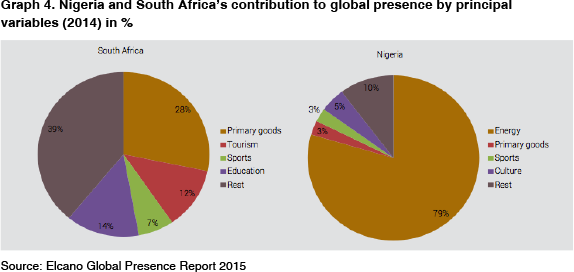
Nigeria stands out from the rest of Sub-Saharan Africa due to its improved global presence results. But a detailed analysis of the nature of the international projection of both Nigeria and South Africa, the two regional leaders, shows how South African influence, being based on diversity, constitutes a more solid and sustainable projection. Indeed, this is an international projection and a strategic incorporation firmly connected to the globalisation process, not only through the economic dimension but also through other factors including the attraction of international students, tourism and sports. All of these are soft variables, indicating a sophisticated pattern more suitable to the ever-growing complexity of the international relations scenario in effect since the end of the Cold War.
Conclusions
As we have seen, the Elcano Global Presence Index is a useful tool to analyse the foreign policy of countries for which it is calculated. Are a country’s current foreign policies coping with weaknesses in that nation’s external projection? Are countries fully exploiting their potential? In the case of Australia, the connection is evident: the shift towards an international economic profile with a liberal bent, in a region –Asia-Pacific– that has become the epicentre of global economic activity, explains to some degree the fact that the economic dimension has become the dominant aspect of the country’s project in order to gain the maximum benefit from globalisation. As for South Africa, its main strength and basis for exerting regional (or even global) influence has been the relative diversification of its global presence around different economic and soft variables, which projects the country in a more complex and sophisticated way in the regional challenge with Nigeria, which bases its global presence on energy exports.
Carola García-Calvo
Analyst, Elcano Royal Institute | @carolagc13
1 Ignacio Molina (coord.) (2014), Hacia una renovación estratégica de la política exterior española, Informe Elcano, nº 15, Real Instituto Elcano, Madrid. Both Executive Summary and Conclusions are available in English.
2 Commonwealth of Australia (2003), Advancing the National Interest: Australia’s Foreign and Trade Policy White Paper.
3 Advancing the National Interest, p. 25-30.
5 Advancing the National Interest, p. 13.
6 Advancing the National Interest, p. 13.
7 Department of Foreign Affairs, Republic of South Africa (2005), South Africa Foreign Policy Strategic Plan: 2005-2008.
8 Department of Foreign Affairs, Republic of South Africa (2011), White Paper on South African Foreign Policy – Building a Better World: The Diplomacy of Ubuntu.
9 See Building a Better World, preamble.
10 Building a Better World, p. 3.
11 Building a Better World, p. 26.
12 Building a Better World, p. 18.
13 Building a Better World, p. 26.
